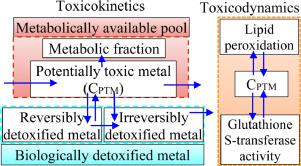Aquatic Toxicology ( IF 4.1 ) Pub Date : 2021-11-02 , DOI: 10.1016/j.aquatox.2021.106015 T T Yen Le 1 , Daniel Grabner 1 , Milen Nachev 1 , Míriam R García 2 , Eva Balsa-Canto 2 , Willie J G M Peijnenburg 3 , A Jan Hendriks 4 , Bernd Sures 1

|
A toxicokinetic-toxicodynamic model based on subcellular metal partitioning is presented for simulating chronic toxicity of copper (Cu) from the estimated concentration in the fraction of potentially toxic metal (PTM). As such, the model allows for considering the significance of different pathways of metal sequestration in predicting metal toxicity. In the metabolically available pool (MAP), excess metals above the metabolic requirements and the detoxification and elimination capacity form the PTM fraction. The reversibly and irreversibly detoxified fractions were distinguished in the biologically detoxified compartment, while responses of organisms were related to Cu accumulation in the PTM fraction. The model was calibrated using the data on Cu concentrations in subcellular fractions and physiological responses measured by the glutathione S-transferase activity and the lipid peroxidation level during 24-day exposure of the Zebra mussel to Cu at concentrations of 25 and 50 µg/L and varying Na+ concentrations up to 4.0 mmol/L. The model was capable of explaining dynamics in the subcellular Cu partitioning, e.g. the trade-off between elimination and detoxification as well as the dependence of net accumulation, elimination, detoxification, and metabolism on the exposure level. Increases in the net accumulation rate in the MAP contributed to increased concentrations of Cu in this fraction. Moreover, these results are indicative of ineffective detoxification at high exposure levels and spill-over effects of detoxification.
中文翻译:

基于亚细胞分馏模拟铜对斑马贻贝的慢性毒性毒代动力学-毒理学模型的开发
提出了一种基于亚细胞金属分配的毒代动力学-毒理学模型,用于从潜在有毒金属 (PTM) 的估计浓度中模拟铜 (Cu) 的慢性毒性。因此,该模型允许考虑不同金属螯合途径在预测金属毒性方面的重要性。在代谢可用池 (MAP) 中,高于代谢需求和解毒和消除能力的过量金属形成 PTM 部分。可逆和不可逆解毒部分在生物解毒区室中被区分,而生物体的反应与 PTM 部分中的铜积累有关。+浓度高达 4.0 mmol/L。该模型能够解释亚细胞铜分配的动力学,例如消除和解毒之间的权衡以及净积累、消除、解毒和代谢对暴露水平的依赖性。MAP 中净积累率的增加导致该部分中 Cu 浓度的增加。此外,这些结果表明在高暴露水平下解毒无效以及解毒的溢出效应。











































 京公网安备 11010802027423号
京公网安备 11010802027423号